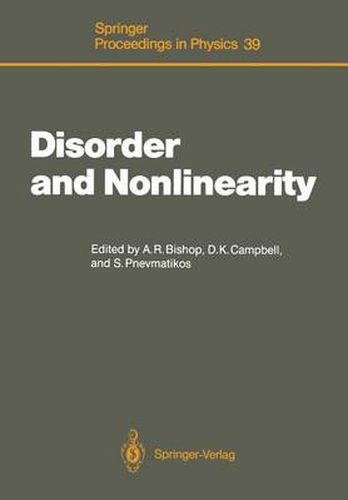Readings Newsletter
Become a Readings Member to make your shopping experience even easier.
Sign in or sign up for free!
You’re not far away from qualifying for FREE standard shipping within Australia
You’ve qualified for FREE standard shipping within Australia
The cart is loading…






This title is printed to order. This book may have been self-published. If so, we cannot guarantee the quality of the content. In the main most books will have gone through the editing process however some may not. We therefore suggest that you be aware of this before ordering this book. If in doubt check either the author or publisher’s details as we are unable to accept any returns unless they are faulty. Please contact us if you have any questions.
ill the past three decades there has been enonnous progress in identifying the es sential role that nonlinearity plays in physical systems. Classical nonlinear wave equations can support localized, stable soliton solutions, and nonlinearities in quantum systems can lead to self-trapped excitations, such as polarons. Since these nonlinear excitations often dominate the transport and response properties of the systems in which they exist, accurate modeling of their effects is essential to interpreting a wide range of physical phenomena. Further, the dramatic de velopments in deterministic chaos , including the recognition that even simple nonlinear dynamical systems can produce seemingly random temporal evolution, have similarly demonstrated that an understanding of chaotic dynamics is vital to an accurate interpretation of the behavior of many physical systems. As a conse quence of these two developments, the study of nonlinear phenomena has emerged as a subject in its own right. During these same three decades, similar progress has occurred in understand ing the effects of disorder . Stimulated by Anderson’s pioneering work on dis ordered quantum solid state materials, this effort has also grown into a field that now includes a variety of classical and quantum systems and treats disorder arising from many sources, including impurities, random spatial structures, and stochastic applied fields. Significantly, these two developments have occurred rather independently, with relatively little overlapping research.
$9.00 standard shipping within Australia
FREE standard shipping within Australia for orders over $100.00
Express & International shipping calculated at checkout
This title is printed to order. This book may have been self-published. If so, we cannot guarantee the quality of the content. In the main most books will have gone through the editing process however some may not. We therefore suggest that you be aware of this before ordering this book. If in doubt check either the author or publisher’s details as we are unable to accept any returns unless they are faulty. Please contact us if you have any questions.
ill the past three decades there has been enonnous progress in identifying the es sential role that nonlinearity plays in physical systems. Classical nonlinear wave equations can support localized, stable soliton solutions, and nonlinearities in quantum systems can lead to self-trapped excitations, such as polarons. Since these nonlinear excitations often dominate the transport and response properties of the systems in which they exist, accurate modeling of their effects is essential to interpreting a wide range of physical phenomena. Further, the dramatic de velopments in deterministic chaos , including the recognition that even simple nonlinear dynamical systems can produce seemingly random temporal evolution, have similarly demonstrated that an understanding of chaotic dynamics is vital to an accurate interpretation of the behavior of many physical systems. As a conse quence of these two developments, the study of nonlinear phenomena has emerged as a subject in its own right. During these same three decades, similar progress has occurred in understand ing the effects of disorder . Stimulated by Anderson’s pioneering work on dis ordered quantum solid state materials, this effort has also grown into a field that now includes a variety of classical and quantum systems and treats disorder arising from many sources, including impurities, random spatial structures, and stochastic applied fields. Significantly, these two developments have occurred rather independently, with relatively little overlapping research.